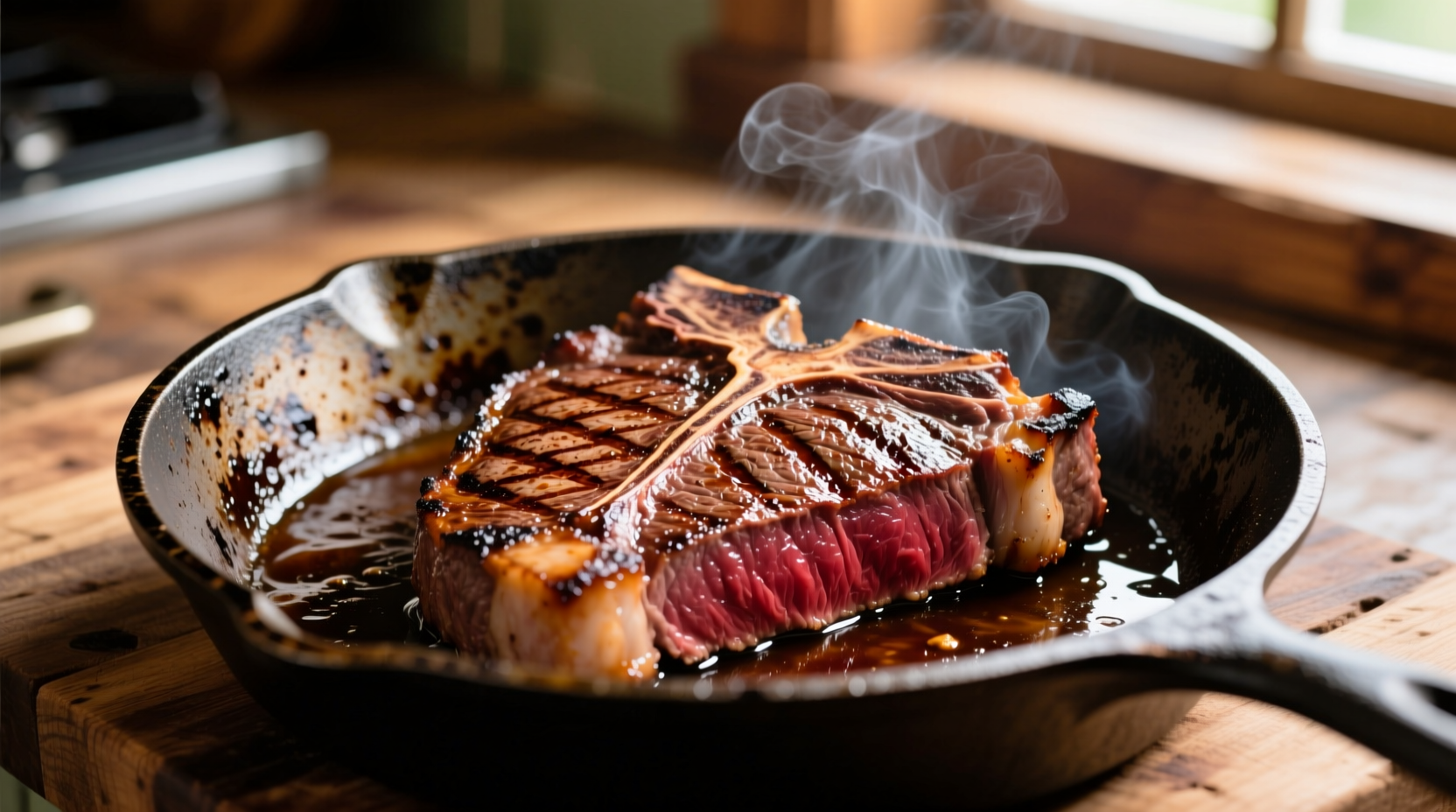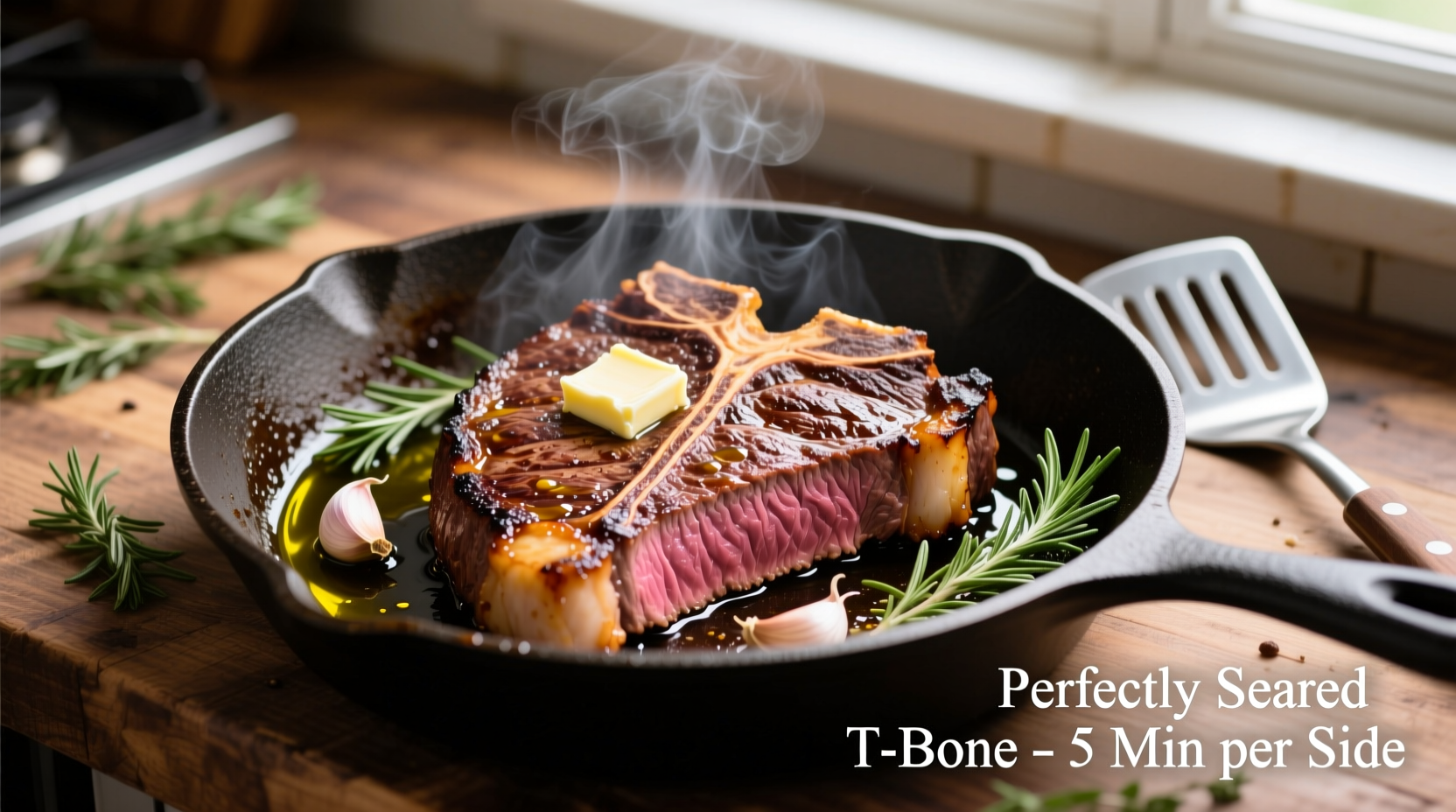The perfect pan-seared T-bone steak requires a 1-1.5 inch thick cut, preheated cast iron skillet, 4-5 minutes per side for medium-rare, and a 5-10 minute rest. This method delivers restaurant-quality results with a flavorful crust and juicy interior when using proper temperature control and technique.
Cooking a T-bone steak in a frying pan seems intimidating, but with the right approach you'll achieve a professional-quality sear and perfect doneness every time. Forget expensive steakhouse prices—this straightforward technique works with basic kitchen equipment and delivers exceptional results in under 20 minutes. Whether you're cooking for a special occasion or weeknight dinner, mastering this method ensures juicy, flavorful steak with that coveted caramelized crust.
Essential Equipment and Steak Selection
Your equipment choices directly impact your steak's outcome. While many home cooks reach for non-stick pans, professional chefs consistently recommend cast iron or carbon steel skillets for steak cooking. These materials retain heat exceptionally well and create the perfect Maillard reaction for that signature crust.
When selecting your T-bone:
- Choose steaks at least 1-1.5 inches thick for proper searing without overcooking
- Look for bright red color with fine marbling throughout the meat
- Allow 12-24 hours of aging for optimal tenderness (most grocery store steaks are already aged)
- Avoid steaks with excessive liquid in the packaging, which indicates poor handling

Preparation: The Critical First Steps
Proper preparation separates good steak from great steak. Never skip these essential steps that dramatically impact your final result:
- Bring to room temperature—Remove steak from refrigerator 45-60 minutes before cooking. Cold meat won't sear properly and will cook unevenly.
- Dry the surface—Pat steak thoroughly with paper towels. Moisture is the enemy of a good sear.
- Season simply—Use coarse kosher salt and freshly ground black pepper. Avoid complex spice blends that overwhelm the meat's natural flavor.
- Preheat your pan—Place skillet over medium-high heat for 5-7 minutes until smoking hot. Test with a few water droplets—they should dance and evaporate instantly.
Mastering the Cooking Process
The cooking phase requires attention to timing and technique. Follow these steps precisely for optimal results:
| Doneness Level | Internal Temperature | Total Cooking Time* |
|---|---|---|
| Rare | 120-125°F (49-52°C) | 6-8 minutes |
| Medium-rare | 130-135°F (54-57°C) | 8-10 minutes |
| Medium | 140-145°F (60-63°C) | 10-12 minutes |
| Medium-well | 150-155°F (66-68°C) | 12-14 minutes |
*For 1.5-inch thick steak, based on USDA Food Safety and Inspection Service guidelines
Follow this cooking timeline for perfect results:
- Initial sear (3-4 minutes)—Place steak in hot pan away from you to avoid oil splatter. Press gently for full contact. Don't move it during this phase.
- First flip (30 seconds)—Use tongs to flip steak. Listen for the satisfying sizzle indicating proper heat.
- Add aromatics (1 minute)—Add 2 tbsp butter, 2 crushed garlic cloves, and fresh rosemary or thyme to the pan.
- Baste continuously (2-3 minutes)—Tilt pan and spoon melted butter over steak repeatedly.
- Check temperature—Insert instant-read thermometer horizontally into thickest part of meat.
- Finish cooking—Continue until 5°F below target temperature (steak will rise during resting).
Avoiding Common Pan-Seared Steak Mistakes
Even experienced cooks make these critical errors that compromise steak quality:
- Overcrowding the pan—Cook one steak at a time in a standard skillet. Multiple steaks lower pan temperature dramatically.
- Moving the steak too soon—Let the crust form before flipping. If it sticks, it's not ready to flip.
- Using wet meat—Moisture creates steam instead of sear. Always pat dry thoroughly.
- Skipping the rest period—Cutting too soon releases precious juices onto your cutting board.
- Using olive oil with low smoke point—Choose avocado oil or clarified butter for high-heat cooking.
The Critical Resting Phase
Resting isn't optional—it's essential for juicy results. When you remove steak from heat, the muscle fibers are tight and juices are concentrated in the center. Resting allows redistribution throughout the meat.
Follow these resting guidelines:
- Transfer steak to a wire rack or warm plate (not cutting board)
- Cover loosely with foil to retain heat without trapping steam
- Rest for 5-10 minutes (longer for thicker cuts)
- During resting, internal temperature will rise 5-10°F
When Pan Cooking Works Best (and When It Doesn't)
While pan-searing delivers excellent results for T-bone steaks, understand these context boundaries:
- Best for: Steaks 1-1.5 inches thick, indoor cooking during colder months, quick weeknight meals
- Alternative methods: Grill for thicker cuts (over 1.5 inches), reverse sear for precise temperature control
- Avoid pan cooking when: Humidity is extremely high (interferes with searing), cooking multiple large steaks
- Special consideration: T-bone's bone side requires slightly longer cooking than the meat side
Troubleshooting Your Pan-Seared Steak
Encountering issues? Here's how to fix common problems:
- Excessive smoke—Reduce heat slightly and ensure proper ventilation. A smoking pan indicates proper temperature, but too much smoke means it's too hot.
- Uneven cooking—Rotate steak 180 degrees halfway through each side for even searing.
- Flare-ups—Temporarily remove steak from pan until flames subside, then return.
- Undercooked center—Finish in 350°F oven for 3-5 minutes after searing.
- Bland flavor—Season more aggressively or add finishing salt after cooking.
Perfect Pairings for Your T-Bone Steak
Complete your meal with these complementary sides that enhance rather than compete with your steak's flavor:
- Classic preparation: Garlic butter mushrooms and roasted asparagus
- Comfort food pairing: Crispy smashed potatoes with rosemary
- Lighter option: Arugula salad with lemon vinaigrette
- Sauce recommendation: Simple pan sauce using deglazed fond, red wine, and butter











 浙公网安备
33010002000092号
浙公网安备
33010002000092号 浙B2-20120091-4
浙B2-20120091-4